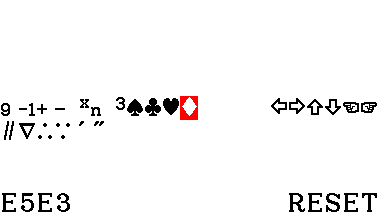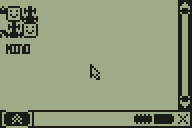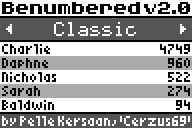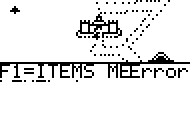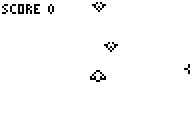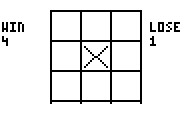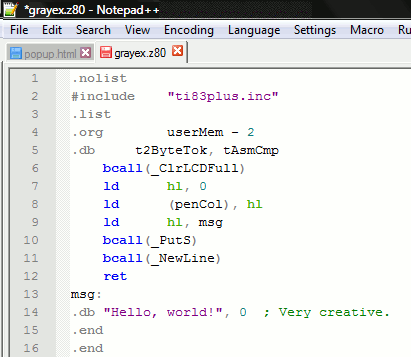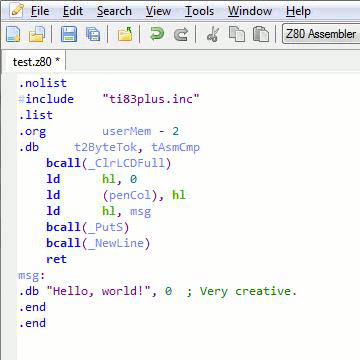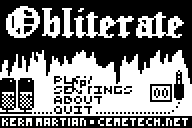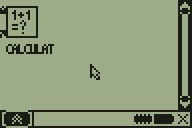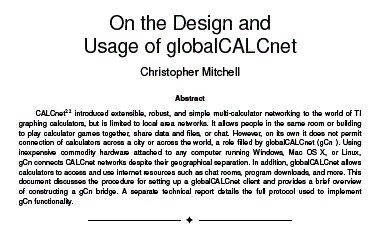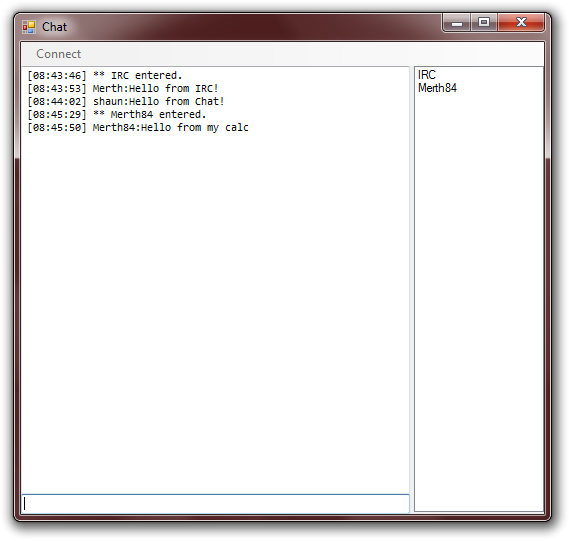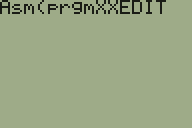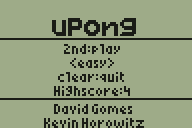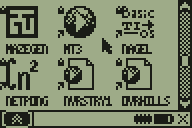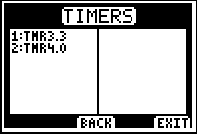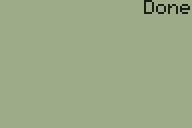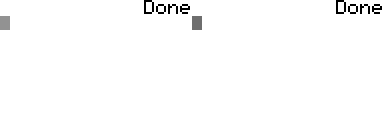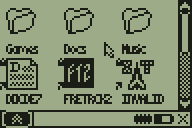Categories
Available subcategories:
- Beta Program Releases
- Casio FX programs
- Casio Prizm (fx-CG) Programs and Games
- Cemetech contest entries
- Computer Programs
- Educational Projects and Lesson Plans
- HP Prime Programs
- TI-73 Programs
- TI-82 Programs
- TI-83 Plus/TI-84 Plus Programs
- TI-83 Programs
- TI-84 Plus C Silver Edition
- TI-84 Plus CE Programs
- TI-85 Programs
- TI-86 Programs
- TI-89 Programs
- TI-92/TI-92 Plus Programs
- TI-Nspire Programs
- Text / Reference Files
- Web Apps and Mods
- Windows Programs
Files
-
Conway's Game of Life for the Casio Prizm.
Categorized under: -
This is a program I wrote to help me find the hex for the various two-byte characters on the Prizm.
Categorized under: -
The classic game Minesweeper now on your Casio Prizm!
Categorized under: -
This program sets up an empty prizm project for you, creating all the files needed by pcgsdk and Visual Studio 2010.
Categorized under: -
This is the newest version of Mino! Now the profils can have costum names, without using any strings to save! The profils can also be password protected. :) xLib is required. Please report bugs!
Categorized under: -
Benumbered v2.0 is a TI-83+/TI-84+ calculator game based on the popular games Bejeweled and Bejeweled 2 by PopCap Games and features spectacular 4-level grayscale graphics, four different gameplay modes and 2 extra unlockable modes, game saving and loading and much more!
Categorized under: -
This is a demo for the RPG EFENDOS. I have completed a lot more than what is on the demo but it is a demo. Pretty cool battle system, with three characters and many opponents. You can fight, level up, defeat castles and expand your forces with your generals. It has scrolling land maps with split screen interface. Try it out and get ready for the release of this awesome game programmed in basic.
Categorized under:
John S. Hood -
(demo) Pixel vs. List
Categorized under:
In this file there are three versions that I attempted to verify which one was faster. The fastest version uses pixels(SPACEIN3 vs. the other two that use lists. One of the list versions uses three plots to plot graphics(SPACEINV, the other uses one plot by augmenting lists(SPACEIN2. These are the trial versions. Version 1.0 will be released in the near future using pixels. For those of you who seek to learn how to program in basic this is a simple game, not too complex so you should be able to figure out how to use this method very easily. After a few attempts you should be able to make games with graphics like these using little time and effort.In this file I have included a tool for everyone to use (PIXELSPR). With this tool you can go to graph screen, draw a sprite, save it to pic9, and then run the program to save you sprite as pixel coordinates on the graph screen. Open a new program, recall lists SPR1 and SPR2 to the program. Then you can reference the pixel coordinates as you enter the PXL(SPR1,SPR2).
John S. Hood
Special Use the 2nd key and keypad to control.[On] to exit.
Thanks to Cemetech for inspiring me to make these demos as demonstrations of pixel and list use. -
Same as Choice 1-6
Categorized under: -
Doors CS 7.2 is the ultimate shell and GUI for your TI graphing calculator. Run any BASIC or ASM program or game, including MirageOS, Ion, Doors CS, and nostub programs. Organize your programs into nested folders, lock, rename, copy, archive, hide, and edit programs directly from Doors CS, or use the HomeRun feature to run any program from the TI-OS homescreen. Doors CS is built to be extremely user-friendly, using a mouse-based interface to appeal to users accustomed to using computers who are frustrated by the many menus one must navigate on a TI calculator. On the opposite end of the user spectrum, it includes myriad keyboard shortcuts so that those who prefer to use a keyboard rather than a mouse can quickly and efficiently move through Doors CS. The Associated Program feature lets you click on any file, like game levels, documents, pictures, and songs, and have them automatically open with the correct viewer program. Doors CS 7.2 builds in the CALCnet2.2 networking library for communication and multiplayer gaming between two, twenty, or two billion calculators, now with I/O and Direct USB support. It contains full libraries for xLIB, Celtic III, PicArc, Omnicalc, and the new DCSB Libs. Download Doors CS 7 today and experience the full power of your calculator!
Categorized under: -
A graphical TI Basic game that is intended to show the power of lists. Hopefully, anyway. It is not a finalized game, but you can play.
Categorized under: -
This was most likely one of the fastest and smoothest TI-83 Plus basic games around when I first created the original release in 1996 for the TI-82. It is fully functional, but there are still a few features that never got completed, as my free time to program for fun slipped away. I hope to get some time to go back and finish my initial objective, which was to program one of the cleanest, most efficient, and smoothly operating basic-coded games out there for the TI-82/83/Plus.
Categorized under: -
Notepad++ is a great tool for developers, featuring syntax highlighting, parenthesis matching, and automatic indentation among other things. It's great for all your coding needs, but it also has a conspicuous lack of syntax support for Z80 assembly programs. This language file adds Z80-specific information for N++ users to enjoy.
Categorized under: -
Programmer's Notepad is a great tool for developers, featuring syntax highlighting, parenthesis matching, and tag closing among other things. It's great for all your coding needs, but it also has a conspicuous lack of syntax support for Z80 assembly programs. This Scintilla scheme file adds Z80-specific information for PN users to enjoy.
Categorized under: -
Obliterate is a scorched-earth/tanks game for Doors CS 7 and TI calculators. Choose from single-player or multi-player mode. Obliterate brings superb graphics, fast and furious gameplay, and cunning AIs to this classic genre and much-loved platform. Challenge any number of AIs to a single-player game, or connect from one to dozens of friends' calculators over CALCnet and go head-to-head in a multiplayer match! Set the angle and power of your shot, watch out for the wind, and take aim at your enemies! The last tank standing wins the match. With the power of the recently-released global CALCnet, you can even play in friends from across town, across the country, or around the world in a game of Obliterate on your calculator.
Categorized under: -
This is a program I made recently, which gives you random calculations to solve. It uses rather much space because it has a rich graphical user interface and a lot of customization.
Categorized under: -
To accompany the 1.0 release of the gCnClient software to connect networks of graphing calculators to and across the internet, this documentation describes the hardware and software necessary to use the gCnClient, including schematics of the gCn bridge device build on a simple commodity Arduino, the alternate cheaper USBHID design for more experienced users, troubleshooting, and instructions for programming the Arduino or USBHID Bridge on Windows, Linux, and Mac OS and using the gCnClient on any operating system.
Categorized under: -
"From the begining of times, since creation, mortal man has always been left free to their choices. But now their is one among the other Gods who opposes that view and strives to influence the mortals in their daily lives. You found out and tried to put an end to it. Little did you know that you were outclassed, and saved yourself by splitting your throne on GodsHome Asunder. Like a star you fell across the night sky hitting mortal ground. This is where darkness rises. And this is when darkness must fall."
Categorized under: -
This is a game i made a while back for TI|BD and its finally made its way to Cemetech! check it out!
Dot mania consist of three games that have everything to do with dots, whether its dodging then, grabbing them, or searching for them! also included is a score board, score grading and a security system so people cant edit your hard earned scores! download it and try it today
Categorized under: -
This is a library for .Net for interfacing with globalCALCnet. With just some simple code you can quickly develop software that interfaces with calculators and other computers on globalCALCnet. Also included is an implementation of Chat!, a chat program written to use CALCnet by myself and Christopher "Kerm Martian" Mitchell. Code is included so you can see how to do it yourself.
Categorized under: -
XXEdit (aXe heX Editor) is the evolution of my old Axe Memory Mapper. It is a comprehensive memory mapper and editor for the z80 series, designed to be a superfunctional form of Calcsys. It is highly useful for helping debug Axe and assembly programs on calc.
Categorized under:
Features:
Memory bank switching
Display of addresses in hex, decimal, and in the form of pointer+offest
Quick access to L1 (saveSScreen), L2 (StatVars), L3 (appBackUpScreen), L4 (tempSwapArea), L5 (textShadow), L6 (plotSScreen), $4000 (the start of Flash), and $8000 (the start of RAM and appData)
Display of byte in hex, binary, decimal, ascii, the two byte number at that point, and the 8x8 sprite of the 8 bytes at the cursor position
Jumping to the currently highlighted two byte address
Jumping to any user defined hex address
Search for any 8 byte string. Accepts input in both hex and ascii
Search for any program/protected program/appvar in RAM or archive.
Edit up to 8 bytes at a time of current cursor position, input accepted as hex or ASCII
Edit via sprite editing of the 8 bytes at the current cursor position
And probably something else I forgot... -
CALCnet Chat! is a multi-user chat program written for Doors CS 7.1 and later. It takes advantages of the powerful CALCnet 2.2 networking protocol for TI graphing calculators ( http://www.cemetech.net/projects/item.php?id=33 ) and the Doors CS GUI API to offer a small yet powerful program. This 2KB program lets you chat with one, one dozen, or one thousand other users at once over CALCnet or globalCALCnet. It has already been used for conversations over 300 miles using gCn, demonstrating its versatility and power. Please test this beta release and report any bugs that you may find!
Categorized under: -
It's finally out, after months of sitting on my calculator. The first 2 playable seasons: Summer and Winter. Winter quest are still buggy. Summer is fully complete, and both seasonal monster sets are done. There are collectible Items to turn in for quest rewards. This RPG includes 5 races with different racial bonuses as well as 5 classes with different bonuses as well. No read me yet sorry, but the game is self explanatory. Game is stopped at death. Enjoy and please post any suggestions or comments under Forums. Thanks!
Categorized under: -
BatLib is actually the app version of SpriteLib with more things that it can do. It is designed to give much more control and functionality to BASIC programs through editing RAM, reading data in programs, sprites, custom fonts, and even playing sounds. There are currently 61 commands, but many are still in there beta forms, so the syntaxes have not been finalised. I tried making notes next to the commands that I plan to change. There is an example program included. The source at the moment is all hex, but I am working on fixing that.
Categorized under: -
So here is the update of Horner. Basically this program factorizes equations of the type ax³+bx²+cx+d=0 as far as we would be able to go ourselves. Have fun trying it out. The updates are notified in the ReadMe.
Categorized under:
Bug reports or requests at Ti84Prgmhuuh@hotmail.com -
uPong: This pong game is not just another pong game, it's an Axe game with lots of features such as greyscale, an easy and hard mode, highscores for each, pausing the game, game over screen, an attractive title screen and a fast game in the overall.
To make this game, I edited Kevin Horowitz's game which was included in Axe: Pong.
The physics of the game are similar, but the addition of two playing modes forced me to change some of the physics.
The game is fast at the moment, I may release an optimized version later but I don't think such version is needed at the moment. To play this game all you need is a shell (I recommend DoorsCS), or you can use the Asm( token to play it. The game is very easy and simple to play, since you only need to use two keys and the gameplay is just like other Pong games.
This game is open source, feel free to view and edit the source code.Thanks to: I would like to thank shmibs, _player1537 and both Cemetech and Omnimaga community, but mainly the first two for helping me with this game. Thanks shmibs for explaining me Appvariables and _player1537 for explaining me how to compare two strings.
Categorized under: -
Its merely a second grade equation factorizer.
Categorized under: -
Chemitab 83+ is a science program that allows the user to look up the symbol and name of any named element on the periodic table (which would be element 112, Copernicium, by the way).
Categorized under:
12/28 - Version 2.0 Released -
Itotooshi is a game where you control a string and try to get it into the circles. This is a DoorsCS game, so you will need
DoorsCS to run it. Run prgmTHRDNDLE to play the game.Compiled with Axe Parser.
Categorized under: -
This program will create a Doors CS 7 header for your Axe programs. It has custom icon support and custom description support.
Categorized under: -
Multitab 83+ is a math program that allows the user to quickly look up the multiples (from zero times to twelve times) of any number inputted by the user. Specifically designed for the TI-83+.
Categorized under: -
This maze generator uses a depth-first search (DFS) algorithm to build moderately difficult mazes. It accepts a passage width parameter from the user; the smaller the passages, the more complex the maze. For speedy recursion, the DCS DFS Maze Generator uses the DCSB Lib AnsStack functions, so you need Doors CS 7.0 or later on your calculator (http://dcs.cemetech.net).
Categorized under: -
This isn't your typical maze. Your perspective is limited by a black mask covering the screen, which you can only see through in one 13x13 square. Have fun beating the two associated mazes. I made them to be extremely difficult. For those of you who aren't brave enough to try, there is also a feature which generates an easier random maze. Good luck. . .
Categorized under: -
I'm sure you all know the famous Nintendo DS game where you have 20, 50 or even 100 simple math calculations which you need to answer as fast as you can. It shows your progress on a daily basis and you have graphs of this progress. Well this should become a similar game for the TI 83/+/SE and TI84/+/SE. This is only version 1.0 and only has the gaming interface. No score keeping yet but still quite nice to play. Only down side, the randomness of the calculations is not that high.
Categorized under: -
This is the last version of my timers. It includes Setup for the graphscreen, Cleanup for erasing all possibly used vars (it's just a general cleanup-prgm I use at the end of all my prgm's), a menu to choose the needed timer.
Categorized under:
The two timers are the TMR3.3, just being a stopwatch and TMR4.0 being a lapcounter. Both timers are integrated with the possibility of pausing the program without pausing the timer so that the calculator can shutdown without compromising the use of the program. Also don't worry about the blank spot it's for personal use, forgot to take it away in the uploaded version. I will make upgrades of this timer, but in the mean time this works just fine I think. -
SpriteLib is a program designed to help BASIC programmers make cooler gam--er, programs. This program started as a Celtic 3 hybrid BASIC program that simply edited Omnicalc fonts and has since come to stand alone as an assembly library equipped with not only font editing features, but sprites, tilemaps, editing variables, reading and writing to memory and other rather useful features. It is by no means complete, but it currently has 40 different functions that will add some advanced features to BASIC programs.
*As a side note, this is all programmed in hex :D
Categorized under: -
English:
A French version of PONG. The game saves the best 5 scores.
(I'm French and I use google trenslate)Français:
Categorized under:
Une version de PONG en français. Le jeu sauvegarde les 5 meilleurs scores! -
A Halo-based RPG. This is the "final" version, with the exception of finishing levels 3-11 and maybe adding a couple more features.
Execute "HALO1ESQ" to start the game (final version will try to condense everything into 1 program).
Overall game size is right at 14K (including all lists/strings that are created and used by the game).
Categorized under: -
You can use SpeedTest 1.0 to benchmark the maximum speed transmission
Categorized under:
capabilities of CALCnet 2.2 between two linked calculators. SpeedTest
supports two types of tests. The first, unidirectional, sets one
calculator as the transmitter and one as the receiver. The transmitter
then repeatedly sends frames to the receiver, and both count the number
of bytes transferred. The second, bidirectional, lets the two
calculators take turns being the sender and receiver. The sender will
send a frame to the receiver, and when the receiver successfully reads
the frame, it will send a frame back to the first calculator. Both
calculators count the number of bytes sent and received. You can read more about CALCnet2.2 at http://www.cemetech.net/projects/item.php?id=33 . -
The second and hopefully last beta version of Doors CS 7.1. Since Doors CS 7.0.1, CALCnet 2.2 has been added, innumerable small bugs and ease-of-use concerns have been addressed, and several corner cases in features such as the DCSB Libs and program hiding have been tracked down and repaired. To test out the CALCnet 2.2 features, Speed Test, NetPong v1.1, and Flourish 1.0 are all available online either in the Cemetech Archives or on ticalc.org. Look for Doors CS 7.1, coming soon to a calculator near you!
Categorized under: -
Flourish is a tech demo for CALCnet 2.2, a calculator networking protocol built into the Doors CS 7.1 shell for TI graphing calculators. This demo juggles a large number of bouncing balls between all of the calculators in a CALCnet 2.2 network, demonstrating the low latency, high throughput, and high reliability of the protocol. Six bouncing, morphing calls are introduced for each calculator in the network, and every time a ball reaches the edge of a screen, it appears instantly on the neighboring calculator. You can see a full video of this program in action at http://www.youtube.com/watch?v=4Mjn98Bs2Cg .
Categorized under: -
I guess this is what programmers do when they are bored. Watch the hated number do something else irrational: Conquer the world! View its progress in grayscale on your trusty TI-83+ calculator.
Categorized under:
File statistics are updated periodically, so numbers shown in this listing may not agree exactly with those shown on individual files.
Advertisement



